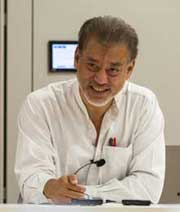Trade, Currency War Weapons Double-Edged
SYDNEY and KUALA LUMPUR, Aug 27 (IPS) - The US-China trade war has flared up again less than two weeks after US President Donald Trump delayed new tariffs of US$160 billion on Chinese imports until December, purportedly to avoid harming the holiday shopping season.
Ratcheting up war talk
Earlier, after two days of trade talks without much progress, Trump claimed on 1 August that China had not kept its promise to buy more US farm exports. He then announced 10 per cent tariffs on US$300 billion worth of Chinese imports, besides the 25 per cent already levied on US$250 billion of goods from China.

China's Commerce Ministry responded on 5 August by stopping purchases of US agricultural products. Its central bank, the People's Bank of China (PBoC) also allowed China's long over-valued renminbi (RMB) currency to fall below the RMB7 per dollar ‘threshold' to its lowest level in more than a decade, causing US equity markets to plunge.
In response, Trump tweeted, "It's called ‘currency manipulation'." Supporting the President, the US Treasury officially claimed, for the first time since 1994, that China was manipulating its currency.
Trump then announced on 9 August that he was not ready to make a deal with Beijing, suggesting that he might cancel the next round of trade talks scheduled in September. Back-tracking on his promise to Chinese President Xi, Trump reaffirmed US business restrictions on Chinese 5G pioneer Huawei.
On 23 August, on the eve of the G7 Summit, China announced new retaliatory tariffs of US$75 billion on US goods, increasing duties by 5-10 per cent on more than 5000 US exports, including food, aircraft and oil, besides re-imposing its 25 per cent duty on US cars.
In more angry tweets, Trump announced higher US tariffs: raising the 25 per cent tariff on US$250 billion of Chinese imports to 30 per cent, and the 10 per cent tariff, announced on 1 August on US$300 billion of Chinese goods, to 15 per cent from 1 September.
Trump also ordered US companies to "start looking for an alternative to China, including bringing your companies HOME and making your products in the USA".
Currency manipulation?
Unsurprisingly, China's actions do not satisfy the US Treasury's own criteria for currency manipulation. Of the three criteria, two were internationally agreed in the IMF's Articles of Agreement: persistent one-sided intervention by a country to push down the value of its currency, and a large current-account surplus. Neither apply to China currently.

After the Tiananmen protests three decades ago, China sought currency stability by virtually pegging its RMB to the US$, imitating Hongkong's official dollar peg from 1983. As its agricultural and manufacturing productivity rose, its exports and trade surplus rose rapidly, causing its currency to become substantially undervalued for more than a decade.
Over a decade ago, China buckled under tremendous international pressure, with the RMB rising by 40 per cent, and probably overvalued in the last decade, especially after it officially became an IMF reserve currency in October 2016.
In the last half decade, the PBoC has intervened to slow RMB depreciation; from mid-2014 to late 2016, it spent about US$1 trillion, a quarter of its foreign exchange reserves, to bolster the RMB, by far, the largest intervention in history to support a currency.
Weaponizing currency
With Chinese economic growth slowing in recent years, US imports from China falling, and an almost balanced current account, the PBoC ending its costly support should weaken the overvalued RMB, and strengthen the greenback, which Trump once wanted to make America great again.
On this, China is not alone, but the US is. Trump regularly accuses others, especially countries the US has large trade deficits with – such as Japan, Korea, Germany, Canada and Mexico – of unfair competition, which he blames on their allegedly undervalued currencies.
In July, Trump tweeted, "China and Europe playing big currency manipulation game … in order to compete with USA. We should MATCH …" Soon after, on 18 July, returning from a G7 Finance Ministers' meeting, Treasury Secretary Steven Mnuchin said the US might intervene in currency markets.
Vicious circle
A ‘beggar thy neighbour' currency war is further destabilizing the already fragile world economy still struggling to recover more than a decade after the global financial crisis without addressing its ‘exorbitant privilege' – of being the premier world reserve currency since the Bretton Woods ‘dollar standard' – enabling its perennial trade deficits.
The US trade deficit is also due to spending more than it produces. The insatiable US consumption appetite – long and still increasingly debt-financed – drives its trade deficit. This is exacerbated by rising budget deficits, worsened by generous tax cuts for the wealthy.
Trump has also blamed the US Federal Reserve, implying Fed Chairman Jerome Powell is a "bigger enemy" for allowing the dollar to strengthen, and pressing him to lower the interest rate as he seeks re-election next year.
The Fed has caved in, citing the growing weakness of the US economy due to the trade war. But lower interest rates will likely only enable more cheap debt-financed consumption and wealth concentration.
The weaker Euro, Japanese Yen and other major currencies in recent months reflect their weak economies. But the more Trump rattles financial markets, the stronger the US dollar will become, regardless of Fed actions, as investors seek refuge in US ‘safe havens'.
As long as the US dollar remains the world's major reserve currency, this fate seems unavoidable. Thus, Trump induced volatility is sending the dollar up, rather than down.
© Inter Press Service (2019) — All Rights Reserved. Original source: Inter Press Service
 Global Issues
Global Issues